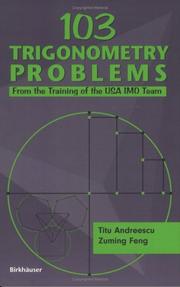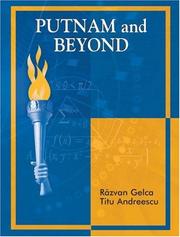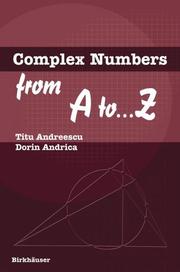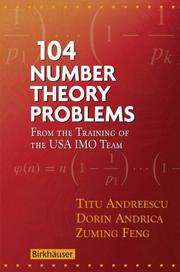| Listing 1 - 10 of 16 | << page >> |
Sort by
|
Book
ISBN: 0817643605 0817646361 9780817643607 Year: 2014 Publisher: New York: Birkhäuser,
Abstract | Keywords | Export | Availability | Bookmark
 Loading...
Loading...Choose an application
- Reference Manager
- EndNote
- RefWorks (Direct export to RefWorks)
This textbook provides a rigorous introduction to linear algebra in addition to material suitable for a more advanced course while emphasizing the subject’s interactions with other topics in mathematics such as calculus and geometry. A problem-based approach is used to develop the theoretical foundations of vector spaces, linear equations, matrix algebra, eigenvectors, and orthogonality. Key features include: • a thorough presentation of the main results in linear algebra along with numerous examples to illustrate the theory; • over 500 problems (half with complete solutions) carefully selected for their elegance and theoretical significance; • an interleaved discussion of geometry and linear algebra, giving readers a solid understanding of both topics and the relationship between them. Numerous exercises and well-chosen examples make this text suitable for advanced courses at the junior or senior levels. It can also serve as a source of supplementary problems for a sophomore-level course. .
Mathematics. --- Computer science --- Algebra. --- Matrix theory. --- Applied mathematics. --- Engineering mathematics. --- Game theory. --- Linear and Multilinear Algebras, Matrix Theory. --- Applications of Mathematics. --- Game Theory, Economics, Social and Behav. Sciences. --- Appl.Mathematics/Computational Methods of Engineering. --- Math Applications in Computer Science. --- Computer science. --- Mathematical and Computational Engineering. --- Informatics --- Science --- Engineering --- Engineering analysis --- Mathematical analysis --- Mathematics --- Math --- Computer science—Mathematics. --- Games, Theory of --- Theory of games --- Mathematical models --- Algebras, Linear. --- Algebras, Linear --- Algebras, Linear - Problems, exercises, etc.

ISBN: 0817644326 0817643346 Year: 2005 Publisher: Boston, MA : Birkhäuser Boston : Imprint: Birkhäuser,
Abstract | Keywords | Export | Availability | Bookmark
 Loading...
Loading...Choose an application
- Reference Manager
- EndNote
- RefWorks (Direct export to RefWorks)
103 Trigonometry Problems contains highly-selected problems and solutions used in the training and testing of the USA International Mathematical Olympiad (IMO) team. Though many problems may initially appear impenetrable to the novice, most can be solved using only elementary high school mathematics techniques. Key features: * Gradual progression in problem difficulty builds and strengthens mathematical skills and techniques * Basic topics include trigonometric formulas and identities, their applications in the geometry of the triangle, trigonometric equations and inequalities, and substitutions involving trigonometric functions * Problem-solving tactics and strategies, along with practical test-taking techniques, provide in-depth enrichment and preparation for possible participation in various mathematical competitions * Comprehensive introduction (first chapter) to trigonometric functions, their relations and functional properties, and their applications in the Euclidean plane and solid geometry expose advanced students to college level material 103 Trigonometry Problems is a cogent problem-solving resource for advanced high school students, undergraduates, and mathematics teachers engaged in competition training. Other books by the authors include 102 Combinatorial Problems: From the Training of the USA IMO Team (0-8176-4317-6, 2003) and A Path to Combinatorics for Undergraduates: Counting Strategies (0-8176-4288-9, 2004).
Trigonometry --- Geometry. --- Algebra. --- Mathematics. --- Mathematics, general. --- Math --- Science --- Mathematics --- Mathematical analysis --- Euclid's Elements --- Trigonometry.

ISBN: 038768445X 0387257659 Year: 2007 Publisher: New York, NY : Springer New York : Imprint: Springer,
Abstract | Keywords | Export | Availability | Bookmark
 Loading...
Loading...Choose an application
- Reference Manager
- EndNote
- RefWorks (Direct export to RefWorks)
Putnam and Beyond takes the reader on a journey through the world of college mathematics, focusing on some of the most important concepts and results in the theories of polynomials, linear algebra, real analysis in one and several variables, differential equations, coordinate geometry, trigonometry, elementary number theory, combinatorics, and probability. Using the W.L. Putnam Mathematical Competition for undergraduates as an inspiring symbol to build an appropriate math background for graduate studies in pure or applied mathematics, the reader is eased into transitioning from problem-solving at the high school level to the university and beyond, that is, to mathematical research. Key features of Putnam and Beyond * Preliminary material provides an overview of common methods of proof: argument by contradiction, mathematical induction, pigeonhole principle, ordered sets, and invariants. * Each chapter systematically presents a single subject within which problems are clustered in every section according to the specific topic. * The exposition is driven by more than 1100 problems and examples chosen from numerous sources from around the world; many original contributions come from the authors. * Complete solutions to all problems are given at the end of the book. The source, author, and historical background are cited whenever possible. This work may be used as a study guide for the Putnam exam, as a text for many different problem-solving courses, and as a source of problems for standard courses in undergraduate mathematics. Putnam and Beyond is organized for self-study by undergraduate and graduate students, as well as teachers and researchers in the physical sciences who wish to expand their mathematical horizons.
Mathematics --- Competitions. --- William Lowell Putnam Mathematical Competition. --- Algebra. --- Global analysis (Mathematics). --- Mathematics. --- Geometry. --- Number theory. --- Combinatorics. --- Analysis. --- Mathematics, general. --- Number Theory. --- Combinatorics --- Algebra --- Mathematical analysis --- Number study --- Numbers, Theory of --- Euclid's Elements --- Math --- Science --- Analysis, Global (Mathematics) --- Differential topology --- Functions of complex variables --- Geometry, Algebraic --- Mathematical analysis. --- Analysis (Mathematics). --- 517.1 Mathematical analysis --- Combinatorial analysis.
Book
ISBN: 1280384166 9786613562081 0817646450 Year: 2009 Publisher: Boston, MA : Birkhäuser Boston : Imprint: Birkhäuser,
Abstract | Keywords | Export | Availability | Bookmark
 Loading...
Loading...Choose an application
- Reference Manager
- EndNote
- RefWorks (Direct export to RefWorks)
Number theory, an ongoing rich area of mathematical exploration, is noted for its theoretical depth, with connections and applications to other fields from representation theory, to physics, cryptography, and more. While the forefront of number theory is replete with sophisticated and famous open problems, at its foundation are basic, elementary ideas that can stimulate and challenge beginning students. This lively introductory text focuses on a problem-solving approach to the subject. Key features of Number Theory: Structures, Examples, and Problems: * A rigorous exposition starts with the natural numbers and the basics. * Important concepts are presented with an example, which may also emphasize an application. The exposition moves systematically and intuitively to uncover deeper properties. * Topics include divisibility, unique factorization, modular arithmetic and the Chinese Remainder Theorem, Diophantine equations, quadratic residues, binomial coefficients, Fermat and Mersenne primes and other special numbers, and special sequences. Sections on mathematical induction and the pigeonhole principle, as well as a discussion of other number systems are covered. * Unique exercises reinforce and motivate the reader, with selected solutions to some of the problems. * Glossary, bibliography, and comprehensive index round out the text. Written by distinguished research mathematicians and renowned teachers, this text is a clear, accessible introduction to the subject and a source of fascinating problems and puzzles, from advanced high school students to undergraduates, their instructors, and general readers at all levels.
Number theory --- Number theory. --- Number study --- Numbers, Theory of --- Algebra --- Mathematics. --- Algebra. --- Combinatorics. --- Number Theory. --- Mathematics, general. --- Combinatorics --- Mathematical analysis --- Mathematics --- Math --- Science --- Zahlentheorie. --- Combinatorial analysis.
Book
ISBN: 081768414X 0817684158 Year: 2014 Publisher: Boston, MA : Birkhäuser Boston : Imprint: Birkhäuser,
Abstract | Keywords | Export | Availability | Bookmark
 Loading...
Loading...Choose an application
- Reference Manager
- EndNote
- RefWorks (Direct export to RefWorks)
It is impossible to imagine modern mathematics without complex numbers. The second edition of Complex Numbers from A to … Z introduces the reader to this fascinating subject that, from the time of L. Euler, has become one of the most utilized ideas in mathematics. The exposition concentrates on key concepts and then elementary results concerning these numbers. The reader learns how complex numbers can be used to solve algebraic equations and to understand the geometric interpretation of complex numbers and the operations involving them. The theoretical parts of the book are augmented with rich exercises and problems at various levels of difficulty. Many new problems and solutions have been added in this second edition. A special feature of the book is the last chapter, a selection of outstanding Olympiad and other important mathematical contest problems solved by employing the methods already presented. The book reflects the unique experience of the authors. It distills a vast mathematical literature, most of which is unknown to the western public, and captures the essence of an abundant problem culture. The target audience includes undergraduates, high school students and their teachers, mathematical contestants (such as those training for Olympiads or the W. L. Putnam Mathematical Competition) and their coaches, as well as anyone interested in essential mathematics.
Geometry. --- Geometry, Algebraic. --- Number theory. --- Mathematics. --- Geometry, algebraic. --- Numbers, Complex --- Mathematics --- Physical Sciences & Mathematics --- Algebra --- Complex numbers --- Imaginary quantities --- Quantities, Imaginary --- Number study --- Numbers, Theory of --- Algebraic geometry --- Math --- Algebraic geometry. --- Number Theory. --- Algebraic Geometry. --- Euclid's Elements --- Geometry --- Numbers, Complex.
Book
ISBN: 0817645284 0817646116 Year: 2009 Publisher: Boston, MA : Birkhäuser Boston : Imprint: Birkhäuser,
Abstract | Keywords | Export | Availability | Bookmark
 Loading...
Loading...Choose an application
- Reference Manager
- EndNote
- RefWorks (Direct export to RefWorks)
This signficantly revised and expanded second edition of Mathematical Olympiad Challenges is a rich collection of problems put together by two experienced and well-known professors and coaches of the U.S. International Mathematical Olympiad Team. Hundreds of beautiful, challenging, and instructive problems from algebra, geometry, trigonometry, combinatorics, and number theory from numerous mathematical competitions and journals have been selected and updated. The problems are clustered by topic into self-contained sections with solutions provided separately. Historical insights and asides are presented to stimulate further inquiry. The emphasis throughout is on creative solutions to open-ended problems. New to the second edition: * Completely rewritten discussions precede each of the 30 units, adopting a more user-friendly style with more accessible and inviting examples * Many new or expanded examples, problems, and solutions * Additional references and reader suggestions have been incorporated Featuring enhanced motivation for advanced high school and beginning college students, as well as instructors and Olympiad coaches, this text can be used for creative problem-solving courses, professional teacher development seminars and workshops, self-study, or as a training resource for mathematical competitions. ----- This [book] is…much more than just another collection of interesting, challenging problems, but is instead organized specifically for learning. The book expertly weaves together related problems, so that insights gradually become techniques, tricks slowly become methods, and methods eventually evolve into mastery…. The book is aimed at motivated high school and beginning college students and instructors...I strongly recommend this book for anyone interested in creative problem-solving in mathematics…. It has already taken up a prized position in my personal library, and is bound to provide me with many hours of intellectual pleasure. —The Mathematical Gazette (Review of the First Edition).
Electronic books. -- local. --- Mathematics -- Study and teaching. --- Mathematics. --- Mathematical Theory --- Mathematics --- Physical Sciences & Mathematics --- Study and teaching. --- Math --- Algebra. --- Geometry. --- Mathematical logic. --- Number theory. --- Combinatorics. --- Number Theory. --- Mathematics, general. --- Mathematical Logic and Foundations. --- Science --- Logic, Symbolic and mathematical. --- Combinatorics --- Algebra --- Mathematical analysis --- Algebra of logic --- Logic, Universal --- Mathematical logic --- Symbolic and mathematical logic --- Symbolic logic --- Algebra, Abstract --- Metamathematics --- Set theory --- Syllogism --- Number study --- Numbers, Theory of --- Euclid's Elements --- Combinatorial analysis.
Book
ISBN: 081768252X 0817682538 Year: 2012 Publisher: Boston, MA : Birkhäuser Boston : Imprint: Birkhäuser,
Abstract | Keywords | Export | Availability | Bookmark
 Loading...
Loading...Choose an application
- Reference Manager
- EndNote
- RefWorks (Direct export to RefWorks)
"I took great pleasure in reading Mathematical Olympiad Treasures, by Titu Andreescu and Bogdan Enescu. This book is the fruit of the prodigious activity of two well-known creators of mathematics problems in various mathematical journals.... In all the chapters, the reader can find numerous challenging problems. All featured solutions are interesting, given in increasing level of difficulty; some of them are real gems that will give great satisfaction to any math lover attempting to solve the problems—or even extend them. I believe strongly that Mathematical Olympiad Treasures will reveal the beauty of mathematics to all students, teachers, and all math lovers." —MAA Online (Review of the First Edition) "...this is one of a long recent series of challenging secondary math books, coauthored by Dr. Titu Andreescu and published by Birkhäuser, a series that has definitely enriched the literature on secondary mathematics—a credit to the coauthor and to the wisdom of the editor." —Zentralblatt MATH (Review of the First Edition) This second edition of Mathematical Olympiad Treasures contains a stimulating collection of problems in geometry and trigonometry, algebra, number theory, and combinatorics. It encourages readers to think creatively about techniques and strategies for solving real-world problems, with new sections, revisions, and many more Olympiad-like problems at various levels of difficulty. The problems are clustered by topic into three self-contained chapters. The book begins with elementary facts, followed by carefully selected problems and detailed, step-by-step solutions, which then lead to more complicated, challenging problems and their solutions. Reflecting the vast experience of two professors and Mathematical Olympiad coaches, the text will be invaluable to teachers, students, and puzzle enthusiasts. The advanced reader is challenged to find alternative solutions and extensions of the proposed problems.
Mathematics. --- Geometry, algebraic. --- Combinatorics. --- Logic, Symbolic and mathematical. --- Number theory. --- Number Theory. --- Algebraic Geometry. --- Mathematical Logic and Foundations. --- Mathematics, general. --- Mathematics --- Physical Sciences & Mathematics --- Mathematics - General --- Algebra --- U.S.A. Mathematical Olympiad. --- U.S.A. Mathematical Olympiad --- USAMO (Competition) --- United States of America Mathematical Olympiad --- Algebraic geometry. --- Mathematical logic. --- Combinatorics --- Mathematical analysis --- Math --- Science --- Algebra of logic --- Logic, Universal --- Mathematical logic --- Symbolic and mathematical logic --- Symbolic logic --- Algebra, Abstract --- Metamathematics --- Set theory --- Syllogism --- Algebraic geometry --- Geometry --- Number study --- Numbers, Theory of --- USA Mathematical Olympiad. --- Combinatorial analysis. --- Geometry, Algebraic.
Book
ISBN: 3319589881 3319589865 Year: 2017 Publisher: Cham : Springer International Publishing : Imprint: Springer,
Abstract | Keywords | Export | Availability | Bookmark
 Loading...
Loading...Choose an application
- Reference Manager
- EndNote
- RefWorks (Direct export to RefWorks)
This book takes the reader on a journey through the world of college mathematics, focusing on some of the most important concepts and results in the theories of polynomials, linear algebra, real analysis, differential equations, coordinate geometry, trigonometry, elementary number theory, combinatorics, and probability. Preliminary material provides an overview of common methods of proof: argument by contradiction, mathematical induction, pigeonhole principle, ordered sets, and invariants. Each chapter systematically presents a single subject within which problems are clustered in each section according to the specific topic. The exposition is driven by nearly 1300 problems and examples chosen from numerous sources from around the world; many original contributions come from the authors. The source, author, and historical background are cited whenever possible. Complete solutions to all problems are given at the end of the book. This second edition includes new sections on quadratic polynomials, curves in the plane, quadratic fields, combinatorics of numbers, and graph theory, and added problems or theoretical expansion of sections on polynomials, matrices, abstract algebra, limits of sequences and functions, derivatives and their applications, Stokes' theorem, analytical geometry, combinatorial geometry, and counting strategies. Using the W.L. Putnam Mathematical Competition for undergraduates as an inspiring symbol to build an appropriate math background for graduate studies in pure or applied mathematics, the reader is eased into transitioning from problem-solving at the high school level to the university and beyond, that is, to mathematical research. This work may be used as a study guide for the Putnam exam, as a text for many different problem-solving courses, and as a source of problems for standard courses in undergraduate mathematics. Putnam and Beyond is organized for independent study by undergraduate and graduate students, as well as teachers and researchers in the physical sciences who wish to expand their mathematical horizons. Reviews of the first edition: The reviewer recommends this book to all students curious about the force of mathematics, especially those who are bored at school and ready for a challenge. Teachers would find this book to be a welcome resource, as will contest organizers. —Teodora-Liliana Radulescu, Zentralblatt MATH, Vol. 1122 (24), 2007 …This extraordinary book can be read for fun. However, it can also serve as a textbook for preparation for the Putnam … for an advanced problem-solving course, or even as an overview of undergraduate mathematics. … it could certainly serve as a great review for senior-level students. — Donald L. Vestal, MathDL, December, 2007.
Mathematics. --- Algebra. --- Mathematical analysis. --- Analysis (Mathematics). --- Geometry. --- Number theory. --- Combinatorics. --- Analysis. --- Number Theory. --- Global analysis (Mathematics). --- Mathematics --- Mathematical analysis --- Combinatorics --- Algebra --- Analysis, Global (Mathematics) --- Differential topology --- Functions of complex variables --- Geometry, Algebraic --- Number study --- Numbers, Theory of --- Euclid's Elements --- 517.1 Mathematical analysis

ISBN: 0817643265 0817644490 Year: 2005 Publisher: Boston, MA : Birkhäuser Boston : Imprint: Birkhäuser,
Abstract | Keywords | Export | Availability | Bookmark
 Loading...
Loading...Choose an application
- Reference Manager
- EndNote
- RefWorks (Direct export to RefWorks)
It is impossible to imagine modern mathematics without complex numbers. Complex Numbers from A to . . . Z introduces the reader to this fascinating subject that, from the time of L. Euler, has become one of the most utilized ideas in mathematics. The exposition concentrates on key concepts and then elementary results concerning these numbers. The reader learns how complex numbers can be used to solve algebraic equations and to understand the geometric interpretation of complex numbers and the operations involving them. The theoretical parts of the book are augmented with rich exercises and problems at various levels of difficulty. A special feature of the book is the last chapter, a selection of outstanding Olympiad and other important mathematical contest problems solved by employing the methods already presented. The book reflects the unique experience of the authors. It distills a vast mathematical literature, most of which is unknown to the western public, and captures the essence of an abundant problem culture. The target audience includes undergraduates, high school students and their teachers, mathematical contestants (such as those training for Olympiads or the W. L. Putnam Mathematical Competition) and their coaches, as well as anyone interested in essential mathematics.
Numbers, Complex. --- Complex numbers --- Imaginary quantities --- Quantities, Imaginary --- Mathematics. --- Algebra. --- Algebraic geometry. --- Geometry. --- Number theory. --- Number Theory. --- Algebraic Geometry. --- Numbers, Complex --- 511.147 --- 511.147 Complex numbers. Imaginaries --- Complex numbers. Imaginaries --- Algebra, Universal --- Quaternions --- Vector analysis --- Geometry, algebraic. --- Mathematics --- Euclid's Elements --- Algebraic geometry --- Geometry --- Mathematical analysis --- Number study --- Numbers, Theory of --- Algebra --- Geometry, Algebraic.

ISBN: 0817645616 0817645276 Year: 2007 Publisher: Boston, MA : Birkhäuser Boston : Imprint: Birkhäuser,
Abstract | Keywords | Export | Availability | Bookmark
 Loading...
Loading...Choose an application
- Reference Manager
- EndNote
- RefWorks (Direct export to RefWorks)
This challenging problem book by renowned US Olympiad coaches, mathematics teachers, and researchers develops a multitude of problem-solving skills needed to excel in mathematical contests and research in number theory. Offering inspiration and intellectual delight, the problems throughout the book encourage students to express their ideas, conjectures, and conclusions in writing. Applying specific techniques and strategies, readers will acquire a solid understanding of the fundamental concepts and ideas of number theory. Key features: * Contains problems developed for various mathematical contests, including the International Mathematical Olympiad (IMO) * Builds a bridge between ordinary high school examples and exercises in number theory and more sophisticated, intricate and abstract concepts and problems * Begins by familiarizing students with typical examples that illustrate central themes, followed by numerous carefully selected problems and extensive discussions of their solutions * Combines unconventional and essay-type examples, exercises and problems, many presented in an original fashion * Engages students in creative thinking and stimulates them to express their comprehension and mastery of the material beyond the classroom 104 Number Theory Problems is a valuable resource for advanced high school students, undergraduates, instructors, and mathematics coaches preparing to participate in mathematical contests and those contemplating future research in number theory and its related areas.
Number theory --- Number study --- Numbers, Theory of --- Algebra --- Number theory. --- Sequences (Mathematics). --- Logic, Symbolic and mathematical. --- Number Theory. --- Sequences, Series, Summability. --- Mathematical Logic and Foundations. --- Mathematical sequences --- Numerical sequences --- Mathematics --- Algebra of logic --- Logic, Universal --- Mathematical logic --- Symbolic and mathematical logic --- Symbolic logic --- Algebra, Abstract --- Metamathematics --- Set theory --- Syllogism --- Mathematical logic. --- Sequences (Mathematics)
| Listing 1 - 10 of 16 | << page >> |
Sort by
|

 Search
Search Feedback
Feedback About UniCat
About UniCat  Help
Help News
News